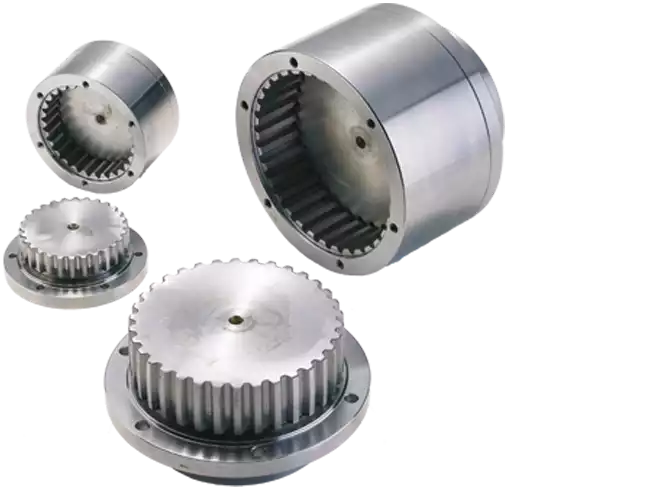Product Description
GIICL drum tooth coupling Gear coupling Intermediate section tooth coupling to figure customization
Description:
1. Strong load-bearing capacity. Under the same outer diameter of the inner gear sleeve and the maximum outer diameter of the coupling, the bearing capacity of the drum gear coupling is increased by an average of 15-20% compared to the straight gear coupling;
2. The angular displacement compensation is large. When the radial displacement is equal to zero, the allowable angular
displacement of the straight tooth coupling is 1o, while the allowable angular displacement of the drum tooth coupling is 1o30 ‘, an increase of 50%. Under the same modulus, number of teeth, and tooth width, the allowable angular displacement of drum shaped teeth is greater than that of straight teeth;
3. The drum shaped tooth surface improves the contact conditions between the inner and outer teeth, avoiding the drawbacks of extrusion and stress concentration at the edge of straight teeth under angular displacement conditions. At the same time, it improves the friction and wear conditions of the tooth surface, reduces noise, and has a long maintenance cycle;
4. The outer gear sleeve has a CHINAMFG shaped tooth end, making it very convenient to assemble and disassemble the inner and outer teeth;
5. Transmission efficiency up to 99.7%;
Based on the above characteristics, drum shaped teeth have been widely used domestically and internationally to replace straight tooth couplings.
Technical data:
Application:
Belt conveyers, csraper conveyers, and conveyers of all kinds Bucket elevators, ball mills, hoisters, crushers, excavators, mixers, straighteners, cranes, etc.
Packing & Delivery:
Tight packaging to protect the product from damage. Support a variety of payment and transportation methods.
FAQ:
Q 1: Are you a trading company or a manufacturer?
A: We are a professional manufacturer specializing in manufacturing
various series of couplings.
Q 2:Can you do OEM?
Yes, we can. We can do OEM & ODM for all the customers with customized artworks in PDF or AI format.
Q 3:How long is your delivery time?
Generally, it is 20-30 days if the goods are not in stock. It is according to quantity.
Q 4: How long is your warranty?
A: Our Warranty is 12 months under normal circumstances.
Q 5: Do you have inspection procedures for coupling?
A:100% self-inspection before packing.
Q 6: Can I have a visit to your factory before the order?
A: Sure, welcome to visit our factory.
/* January 22, 2571 19:08:37 */!function(){function s(e,r){var a,o={};try{e&&e.split(“,”).forEach(function(e,t){e&&(a=e.match(/(.*?):(.*)$/))&&1

Materials Used in Manufacturing Tooth Couplings
Common materials used in manufacturing tooth couplings include:
- Steel: Steel is a popular choice due to its high strength and durability. It can handle heavy loads and is suitable for a wide range of applications.
- Cast Iron: Cast iron is known for its excellent wear resistance and ability to dampen vibrations. It is often used in applications where shock absorption is important.
- Stainless Steel: Stainless steel is corrosion-resistant and can withstand harsh environments, making it suitable for industries like food processing and marine applications.
- Aluminum: Aluminum is lightweight and offers good corrosion resistance. It’s commonly used in applications where weight reduction is important.
- Bronze: Bronze is used for its self-lubricating properties and resistance to corrosion. It’s often employed in applications where lubrication is challenging.
The choice of material depends on factors such as the specific application, operating conditions, and required performance characteristics. Engineers select materials that offer the best combination of strength, durability, corrosion resistance, and other properties needed for the intended use of the tooth coupling.

Recent Advancements in Tooth Coupling Technology
Recent innovations in tooth coupling technology have led to improvements in performance, durability, and ease of use. Some noteworthy advancements include:
- Advanced Materials: The use of high-strength alloys and advanced surface treatments enhances the wear resistance and longevity of tooth couplings.
- Optimized Designs: Computer-aided design (CAD) and finite element analysis (FEA) techniques allow for more precise tooth profile designs, resulting in improved load distribution and reduced stress concentrations.
- Lubrication Solutions: Innovative lubrication techniques, such as self-lubricating coatings and improved lubricant formulations, help reduce friction, wear, and maintenance requirements.
- Smart Monitoring: Integration of sensors and monitoring systems enables real-time data collection on coupling performance, facilitating predictive maintenance and preventing unexpected failures.
- Reduced Backlash: Enhanced tooth engagement geometry and manufacturing techniques minimize backlash, resulting in smoother torque transmission and improved precision.
- Modular Configurations: Modular tooth coupling designs allow for easier assembly, disassembly, and replacement of individual components, reducing downtime during maintenance.
- Corrosion Resistance: Advances in corrosion-resistant coatings and materials make tooth couplings suitable for harsh environments and corrosive substances.
These advancements contribute to increased reliability, efficiency, and overall performance of tooth couplings in various industrial applications.

Types of Tooth Couplings for Specific Uses
There are various types of tooth couplings designed to cater to specific application requirements:
- Spur Tooth Couplings: These are the most common type, with straight teeth that transmit torque and handle misalignment.
- Helical Tooth Couplings: Helical teeth reduce noise, vibrations, and backlash while providing smooth torque transmission.
- Bevel Tooth Couplings: Ideal for applications where shafts intersect at an angle, such as in right-angle drives.
- Internal Tooth Couplings: Suitable for applications where space is limited and torque needs to be transmitted through the inside of the coupling.
- Sliding Tooth Couplings: These allow axial movement between shafts while transmitting torque, making them useful in applications with varying distances.
- Flexible Tooth Couplings: These accommodate misalignment and dampen vibrations, commonly used in pumps, compressors, and turbines.
The choice of tooth coupling type depends on factors like torque requirements, misalignment, space constraints, and specific application demands.


editor by CX 2024-04-13
by
Leave a Reply